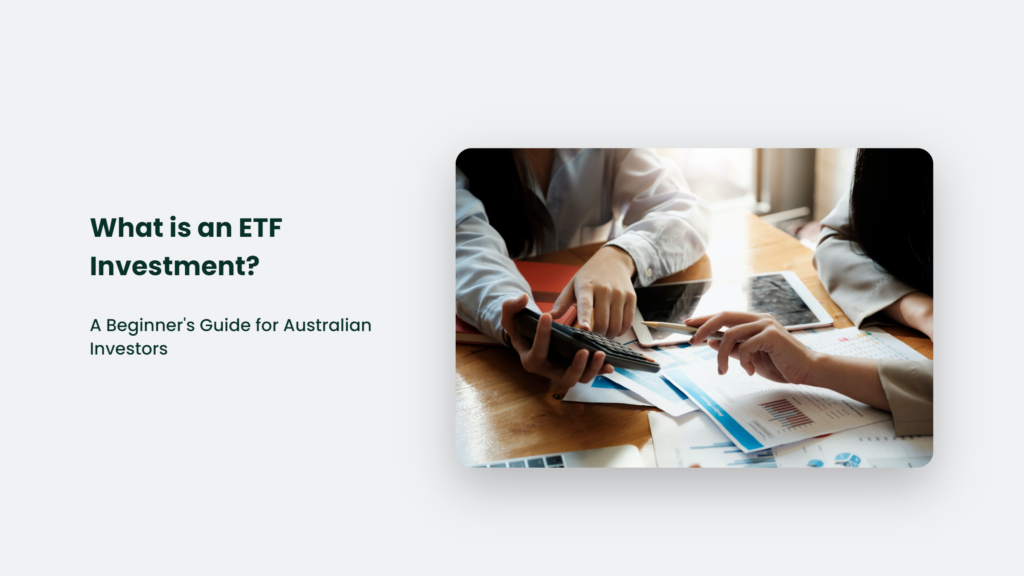

What is an ETF Investment? A Beginner’s Guide for Australian Investors

As Seen On
Exchange-traded funds (ETFs) have become an increasingly popular investment vehicle for Australians looking to gain exposure to a wide variety of assets in a simple, low-cost way. But what exactly are ETFs, and how do they work? This beginner’s guide will explain everything you need to know about ETF investments from an Australian perspective.

What is an ETF Investment?
An ETF or exchange-traded fund is a collection of securities like stocks or bonds that tracks an underlying index, sector, commodity or other assets. ETFs are listed on a stock exchange, so they can be easily bought and sold like stocks during the trading day. It differs from managed funds, which only trade once a day after market close.
Some key features of ETFs:
- Diversification: A single ETF can contain hundreds or thousands of individual assets, providing instant diversification. It reduces risk compared to investing in just a few stocks.
- Low Cost: ETFs have lower management fees than actively managed funds, often less than 0.5% p.a. This saves money over time.
- Transparency: ETF holdings are published daily, so you always know exactly what you own.
- Liquidity: ETFs trade throughout the day, so you can buy and sell quickly. Liquidity is often higher than the underlying holdings.
- Flexibility: ETFs allow exposure to assets like commodities or international stocks that are otherwise difficult to access.
- Tax Efficiency: ETFs tend to distribute less capital gains than managed funds, making them more tax-effective for investors.
Types of ETFs available in Australia
Australia has a mature ETF industry with over 240 ETFs and over $60 billion in funds under management. Here are some of the main types of ETFs available:
- Index ETFs – Track major indexes like the ASX 200 or S&P 500. Great for getting broad market exposure at a low cost. Examples include STW and VAS.
- Sector/Industry ETFs – Invest in specific sectors like healthcare or financials. Allows targeting areas expected to outperform. Examples include IHH and MVA.
- Thematic ETFs – Focus on investments related to a theme like robotics or ethical investing. Allows accessing niche segments. Examples include RBTZ and ETHI.
- Commodity ETFs – Track the price of commodities like gold or oil. Useful for diversification or hedging portfolios. Examples include GOLD and OOIL.
- Bond ETFs – Hold portfolios of government or corporate bonds. Provide income and diversification from equities. Examples include IAF and VAF.
- International ETFs – Track indexes or sectors in overseas markets. Useful for global diversification. Examples include IWLD and EEU.
- Active ETFs – A small but growing segment where the manager actively selects stocks rather than tracking an index. Provides potential outperformance but higher fees, such as RARI.
Benefits of ETF Investing
There are many good reasons why ETFs have become a popular investment choice for Australians:
- Low Cost – ETFs have lower management fees than actively managed funds, often less than 0.5% p.a. compared to over 1% for active funds. This compounds over time.
- Diversification – A single ETF can expose hundreds of different securities across a market segment. It reduces portfolio risk.
- Liquidity – ETFs trade throughout the day like stocks, so entering or exiting a position is easy. Managed funds only trade once a day.
- Transparency – ETF holdings are published daily, so you always know exactly what assets you own.
- Flexibility – The wide range of ETFs available allows investors to target specific markets, sectors or themes.
- Tax Effective – ETFs tend to distribute fewer capital gains than actively managed funds, making them more tax effective.
- Hands-Off Investing – Passive ETFs track an index, so there is no need to pick individual stocks or pay for active management.
Things to consider before investing in ETFs
While ETFs have many benefits, there are also some things to keep in mind:
- Costs – Each ETF charges a management fee, normally less than 0.5% p.a. Plus, there are brokerage costs to buy and sell.
- Tracking error – Index ETFs may not perfectly match the index they track. Check historical performance.
- Liquidity – While most ETFs are highly liquid, some niche ETFs may have low trading volumes.
- Distributions – ETFs distribute dividends and capital gains that must be included in your tax return annually.
- Diversification – Holding just 1-2 ETFs may need to provide more diversification. Research optimal asset allocation.
How to invest in ETFs in Australia
Investing in ETFs is easy in Australia:
- Open a brokerage account – Online brokers like CommSec, SelfWealth or Pearler offer quick and low-cost access to invest in ETFs.
- Research ETFs – Use ETF screening tools to find ETFs matching your investment goals and risk tolerance.
- Buy ETF units – Place a buy order through your broker, just like purchasing shares. Decide on a one-off purchase or regular investing plan.
- Monitor performance – Track your ETFs compared to benchmarks. Rebalance portfolio over time if needed.
- Sell ETF units – Place a sell order to liquidate your position. Consider tax implications before selling.
Frequently Asked Questions:
What are the main benefits of ETFs?
The key benefits of ETFs are diversification, low costs, transparency, liquidity, flexibility and tax efficiency compared to other managed fund investments.
What is the difference between an ETF and a managed fund?
The main difference are that ETFs trade on an exchange so can be bought and sold anytime like stocks. Managed funds only trade once per day. ETFs are passively managed, while actively managed funds involve stock picking by a portfolio manager.
What are the risks associated with ETF investing?
ETFs have lower risks than investing in individual stocks but still carry market risk. Other risks include tracking error from the index, low liquidity for some ETFs and costs eroding returns. Diversification across ETFs is recommended.
Conclusion
In summary, ETFs provide Australian investors with a simple, flexible and low-cost way to gain exposure to a diverse range of asset classes. With the massive choice of ETFs available, investors can target specific markets or themes aligned to their financial goals. Just be sure to research ETF costs, liquidity and diversification before investing. Used appropriately as part of a balanced portfolio, ETFs can be a valuable tool for building long-term wealth.
Konger
Up until working with Casey, we had only had poor to mediocre experiences outsourcing work to agencies. Casey & the team at CJ&CO are the exception to the rule.
Communication was beyond great, his understanding of our vision was phenomenal, and instead of needing babysitting like the other agencies we worked with, he was not only completely dependable but also gave us sound suggestions on how to get better results, at the risk of us not needing him for the initial job we requested (absolute gem).
This has truly been the first time we worked with someone outside of our business that quickly grasped our vision, and that I could completely forget about and would still deliver above expectations.
I honestly can't wait to work in many more projects together!
Disclaimer
*The information this blog provides is for general informational purposes only and is not intended as financial or professional advice. The information may not reflect current developments and may be changed or updated without notice. Any opinions expressed on this blog are the author’s own and do not necessarily reflect the views of the author’s employer or any other organization. You should not act or rely on any information contained in this blog without first seeking the advice of a professional. No representation or warranty, express or implied, is made as to the accuracy or completeness of the information contained in this blog. The author and affiliated parties assume no liability for any errors or omissions.

